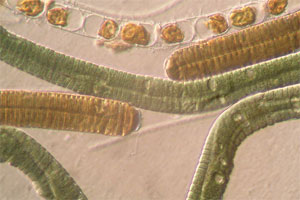 This photomicrograph shows Cyanobacteria (green) found
This photomicrograph shows Cyanobacteria (green) found
in a common pond. Image source: Wayne LanierLast blog I talked about mitochondria. These are the parts of a cell that ultimately turn our food into energy. They also have a very interesting past.
A billion years ago or so, mitochondria were free living bacteria. Then our ancestors hijacked them and now they do our bidding. And mitochondria aren't the only cells that got hijacked. So did the chloroplast’s ancestors.
Chloroplasts are the part of a plant cell that turns sunshine into sugar. Every green plant that we’ve looked at has them. And chloroplasts were almost certainly once free living cyanobacteria.
Both mitochondria and chloroplasts still have many bacterial qualities including having their own DNA. But they don't have a lot of their old DNA left. Most of it has migrated to where the rest of our DNA is kept—the nucleus. Or at least that's the theory.
Do scientists have any proof that DNA can move in a cell from compartment to compartment? As a matter of fact they do. At least with the chloroplast.
